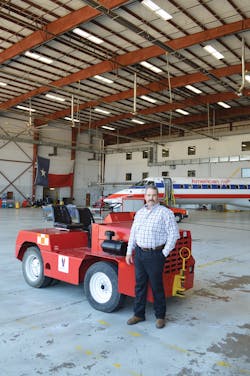“I nominated Travis because he is pure GSE,” Domingo Garcia, told us why he picked Travis Blair, managing director of ground support/administration for American Eagle Airlines Inc., for this year’s Ground Support Leader award.
“I’ve known Travis for quite a while and watched his progress from starting out as a skilled GSE mechanic,” Garcia adds. “All of his titles have had something to do with GSE.”
Garcia, a transportation broker for Echo Global Logistics Inc., counts American Eagle as one of his customers now, but earlier in each man’s career, they both spent time working as automotive mechanics before their paths crossed in the 1990s when they worked together at American Eagle.
“If it doesn’t have wings, and if it’s not connected to the building,” Travis told us, “then it’s basically our responsibility to take care of it.” That means overseeing about 8,000 pieces of GSE in 200 cities supported by 12 shops of mechanics from his offices in Fort Worth, TX.
A GOOD START
Before we had the opportunity to talk with Travis we found out plenty about his career in a detailed resume posted on his LinkedIn profile.
Short of eight years spent fixing cars at Youngblood Automotive, Euless, TX, he’s held one job after another each with increasing responsibility to first fix GSE, then to run a GSE shop, onto running a region and, then, finally, to supervise the whole works from the airline’s headquarters. And he’s done it all for nearly the past 20 years staying with one company.
“I was looking for something bigger,” Travis says of his first venture into the industry as a ground support technician in 1995. “I decided to go with a bigger company where there'd be a few more places to go.”
No doubt about it. “I knew coming into the industry that I’d start from the bottom,” he adds. “But I soaked up everything I could and learned everything I could and worked myself up in the organization however I could.”
Travis spent his few three years learning to repair just about every piece of GSE. He also spent time on the road traveling to outstations to perform preventative maintenance and repair equipment.
He also filled in as a crew chief when needed, before the airline promoted him to his first managerial role, which always comes with a tough transition within a close-knit job of mechanics – and that’s the day you stop being a “friend” and starting being “the boss.”
“I had been a counterpart with several guys that I'd gotten really close to as friends and, suddenly, when you become their boss you learn quickly who your real friends are,” Travis explains. “
But Travis also quickly discovered he had that knack that not all new managers find out they possess – an ability to get everyone to pull together for a common goal.
DEALING WITH CHANGE
Such a skill really was a great trait to have in 2008 when airline made some its biggest changes in its history.
American Eagle began as a collection of regional carriers with contracts to carry the American Eagle brand name. Until 1987, by and large, these third-party carriers flew under contract with American Airlines to provide regional feed to its hubs. Then, starting in 1987, corporate parent AMR Corp. acquired its regional carriers, starting with Simmons Airlines. By mid-1991 AMR had consolidated the number of carriers to four. The May 15, 1998, merger of Wings West and Flagship into Simmons (and the name change of Simmons Airlines to American Eagle Airlines) reduced the number of carriers flying as American Eagle under separate operating certificates to two: American Eagle Airlines, Inc. and Executive Airlines, Inc.
While much of these changes affected airline operations, the GSE maintenance activities still remained a rather loose-knit confederation.
A GSE manager could, rightly or wrongly, consider himself a king of the world. Back then, the country was cut up into a number of different regions. The GSE manager reported to a vice president and then, of course, that vice president reported to one senior vice president.
It was still all “American Eagle,” more or less by name no doubt, but the reporting structure didn’t always work with one mind.
“With GSE managers reporting to different people, they didn’t always have the same directive,” Travis explains. “For example, let’s say the Chicago region made a modification to its belt loaders that made sense for them. But if the company needed to shuffle GSE to other parts of the country, then that “Chicago” modification might not work in a different city.”
Add those small changes up over thousand of piece of equipment, and the airline’s executive management realized it would be best to flatten out the GSE reporting hierarchy.
“That was a huge change,” Travis says. “I'm not one to go in and make drastic changes. I go a little bit slow at things and listen to everybody. I don't run an organization in which I'm making all the decisions. To me every great manager surrounds himself with great people and you got to use those people. You don't do it by yourself.”
Keeping an open mind, particularly when affecting the type change the airline was implementing at the time, is the one trait he tries to teach to every member of his staff.
“We may not like it today,” he adds, “but there may be a good reason for it and tomorrow we're going to think, ‘Hey that was the best idea ever.’ ”
Since 2008, Travis knows that the consolidation has proved its worth to the bottom line. Thanks to weekly calls and other group-sharing activities, he’s seen the GSE department both grow and yet still save thousands of dollars year over year.
“Thinking about it as a system instead of just a region has saved us a lot of money,” Travis adds. Parts that, for example, were bought region to region are now consolidated into one larger purchase made at a lower bulk rate.
GROUND HANDLING
Travis is also lending his hand to American Eagle Ground Handling, one of the airline’s most recent ventures. The business started a few years ago and has already picked up business at about 20 airports, including for other airlines, such as United.
“There’s another change for us,” Travis adds. “GSE is, unfortunately, a part of overhead. It's a necessary part of overhead, something that's needed, but I would love to be able to make it a revenue stream.”
Eagle Ground Handling, for example, was a contract in 2012 to handle United Express ground handling operations at nine U.S. locations.
Currently, Eagle Ground Handling provides ground handling services for other airlines in Waco, College Station, Killeen/Fort Hood and Tyler, Texas, as well as Monroe, La. As a result of these awards, it will add ground handling services for United Express at those stations, along with Dallas Love Field, Del Rio and Beaumont/Port Arthur, Texas, plus Binghamton, N.Y.
"We are excited about this opportunity to expand our relationship with United Express," said Pedro Fabregas, American Eagle's senior vice president of customer service, in a prepared release. "Our team at Eagle Ground Handling is the best in the industry, and we look forward to providing our excellent services at these nine locations."
The number one goal of the airline is, of course, to care of its own customers, but Travis sees plenty of opportunity to keep the GSE running for more airlines than one.
e-GSE Accounts For 30 Percent Of American Eagle’s GSE Inventory
Travis Blair estimates that about a third of all his GSE is electric, with Lektro and Charlatte, among the brands.
“We try very hard to go with electric whenever we can,” he adds. “Electric is a little more expensive, but in the long haul it's better. It's less to maintain and better for the environment.”
About the only issue that holds back the airline’s further e-GSE purchases is lack of infrastructure at smaller airports that American Eagle services.
“We might be the “biggest” airline is some airports with three flights a day,” he explains. “Even that’s slowly changing, but we run into the cases here and there where we'd love to put in electric, but the airports just don't have the power available.”
Putting Out Fires – One Way Or Another
Considering his long, uninterrupted career in mechanics, we were surprised to find that Travis Blair had another all together different job in mind.
“When I graduated high school, my plan was to be a firefighter,” Travis says. First, he needed 60 college hours and found an automotive tech school that could give him those hours in nine months. Growing up a farm, mechanical skills can come naturally or by necessity.
“My dad didn’t believe in taking anything to a shop,” he says. “Either you fixed it yourself or it didn’t get done.”
But Travis found out the money was good working on cars and stuck with it.
When he joined the GSE industry eight years later, he actually took a pay cut.
“I thought I was a pretty good mechanic,” he says, “but then I came to the airline and found out quickly that I wasn't as good as I thought.”
He says he also learned something just as fast about GSE repair.
Planes aren’t likely to go anywhere without GSE. And when a piece of equipment breaks down, the GSE mechanic knows his ETA is best measured in minutes.
“GSE is a tough job because people aren’t calling you to see if you want to go get some lunch,” Travis adds. “They’re calling you to complain something is broken.”
With that type of pressure, Travis says it takes somebody who really enjoys his work. And as he moved up in his career, Travis realized his first choice of careers might not be that different from the one he ended with.
“Over the years, I realized I really am doing what I set out to do,” he explains. “I wanted to be a firefighter, and I'm stomping out a new fire every hour.”

